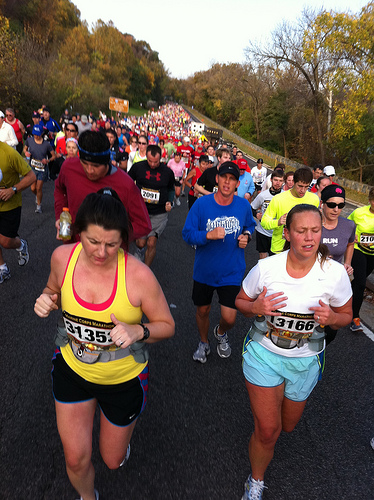My recent “Ask Crazy Legs” post brought in some great new questions that I’m excited to answer for you…
Crazy Legs,
How do you deal with the aging process? Especially the part that includes running slower? It depresses me.
kara
Kara,
First a few facts. It would appear that the body reaches peak efficiency at the age 30 and then declines in many ways. Using age 30 as reflective of 100% performance, we see the following: (a) pumping efficiency of the heart is reduced about 20% when a person reaches 55, (b) kidney function is reduced about 25% at 55 years of age, (c) maximum breathing capacity declines about 40% by 55 and 60% by 75 years , (d) basal metabolism rate goes down about 10%. (Resource: http://www.therubins.com/aging/process1.htm)
Sorry for depressing you more but you can not stop father time. But performing endurance exercises, like walking, running or swimming, improves the health of your heart, lungs, and circulatory system. They may also delay or prevent diseases such as diabetes, colon cancer, heart disease, osteoporosis, and stroke.
As we age we will also lose speed while running but your endurance is still there. Maybe it is time to try ultra marathons (i.e. 50k, 50 and 100 milers) where speed is not important instead finishing becomes your goal.
Crazy Legs,
I’m training for a half marathon in 3 weeks. Unfortunately, I just found out that there are 2 significant hills on the course!!!!
What should I do??? Any last-minute training hints?
Carrie
Carrie,
Here some tips for uphill and downhill running:
When running uphill, increase stride rate and shorten your stride slightly, which will keep your center of gravity over or slightly ahead of your lead foot, and lift your knees a little more than usual on the flats. Also, increase your arm swing slightly. Driving the arms a little harder will help to overcome the pull of gravity.
When running downhill, lengthen your stride a little and pay attention to your footstrike. Avoid hard heel strikes, which indicates that you are leaning back and overstriding with your knees too straight or locked and a lot of shock transmitted to your legs, knees, and hips. Try to land midfoot or forefoot with your knees flexed. A gentle heel strike followed by a quick roll onto the forefoot is OK if “forcing” a midfoot landing isn’t comfortable. Unlike running uphill, an exaggerated arm swing is counter-productive when running downhill. Gravity provides the power going downhill. The arms are used mostly to maintain balance and rhythm
Hey Crazy Legs,
Training for my first half-marathon has been sidetracked. I had to take a month off and pretty much lost my base.The race is in 2 weeks, and I haven’t put all the time and the miles in for preparation. In order to avoid injuring myself I’ve been doing a longer run on sundays (between 6 and 8 miles so far) and one or two 4-5 mile runs during the week.Am I screwed? I’m not looking break any records–I just want to finish it without injury.
Harv
Harv,
As a running coach, I would recommend not running the race. I tend to see people who did not properly train try to “wing it” in a half or full marathon. Many of these runners end up with serious injuries that sideline them for months. You should get your training back on track and find another half-marathon that you can do properly trained.

